Optimization of Recharge Schemes for Deep Excavation in the Confined Water-Rich Stratum
Abstract
1. Introduction
2. Project Overviews
3. Methods
3.1. The Orthogonal Test Model
3.2. Establishment of Numerical Model
3.3. Optimization Method Based on Multi-Target Orthogonal Test Design
4. Results and Discussion
4.1. The Results of Orthogonal Test
4.2. Influence of Recharge Parameters on Ground Settlement
4.3. Influence of Recharge Parameters on the Flux of Groundwater Recovery
4.4. Influence of Recharge Parameters on the Horizontal Displacement of Retaining Structure
4.5. Influence of Recharge Parameters on the Influence Radius of Recharge
4.6. Influence of Recharge Parameters on the Construction Difficulty
4.7. The Optimization of Recharge Scheme
5. Conclusions
- (1)
- In terms of ground settlement and the flux of groundwater recovery, the main influential factor is the recharge pressure and the depth of recharge well. The main influential factor of retaining structure deformation and influence radius of recharge is the distance between recharge wells and retaining wall. Construction difficulty increases approximately linearly with the four typical recharge parameters.
- (2)
- Recharge can restore the seepage flux of groundwater to a certain extent and thereby reduce the ground settlement caused by dewatering effectively. The water pressure brought by recharge is coupled with the soil stress around the foundation pit, which aggravates the unbalanced pressure on both sides of the retaining structure and leads to further deformation of the pit retaining structure.
- (3)
- In a pit with thick high-permeability soil layers, the recharge scheme A5B2C1D4 (the depth of recharge well is 50 m, distance between recharge well and retaining wall is 20 m, spacing is 10 m, pressure is 40 kPa) can recover the groundwater seepage flux to the maximum extent and reduce the adverse effects of recharge on the retaining structure. The method of obtaining the optimal scheme can provide a reference for the groundwater recharging of the deep excavation in a water-rich confined area.
Author Contributions
Funding
Institutional Review Board Statement
Informed Consent Statement
Data Availability Statement
Conflicts of Interest
References
- Zhang, Y.Q.; Wang, J.H.; Li, M.G. Effect of Dewatering in a Confined Aquifer on Ground Settlement in Deep Excavations. Int. J. Géoméch. 2018, 18, 04018120. [Google Scholar] [CrossRef]
- Tornborg, J.; Karlsson, M.; Kullingsjö, A.; Karstunen, M. Modelling the construction and long-term response of Göta Tunnel. Comput. Geotech. 2021, 134, 104027. [Google Scholar] [CrossRef]
- Zeng, C.-F.; Wang, S.; Xue, X.-L.; Zheng, G.; Mei, G.-X. Characteristics of ground settlement due to combined actions of groundwater drawdown and enclosure wall movement. Acta Geotech. 2022, 17, 4095–4112. [Google Scholar] [CrossRef]
- Pujades, E.; Jurado, A. Groundwater-related aspects during the development of deep excavations below the water table: A short review. Undergr. Space 2019, 6, 35–45. [Google Scholar] [CrossRef]
- Liu, F.; Xing, H.; Wu, B.; Liu, G.; Ma, S.; Huang, H.; Meng, G. Study on the effect of dewatering-recharge-excavation of deep foundation pits on soil-structure-groundwater under a deep confined water environment. Arab. J. Geosci. 2022, 15, 710. [Google Scholar] [CrossRef]
- Ervin, M.C.; Benson, N.D.; Morgan, J.R.; Pavlovic, N. Melbourne’s Southbank Interchange: A permanent excavation in compressible clay. Can. Geotech. J. 2004, 41, 861–876. [Google Scholar] [CrossRef]
- Zhang, Y.-Q.; Wang, J.-H.; Chen, J.-J.; Li, M.-G. Numerical study on the responses of groundwater and strata to pumping and recharge in a deep confined aquifer. J. Hydrol. 2017, 548, 342–352. [Google Scholar] [CrossRef]
- Zhang, Y.; Yan, X.; Yang, T.; Wu, J.; Wu, J. Three-Dimensional Numerical Investigation of Pore Water Pressure and Deformation of Pumped Aquifer Systems. Groundwater 2019, 58, 278–290. [Google Scholar] [CrossRef]
- Wang, J.; Liu, X.; Wu, Y.; Liu, S.; Wu, L.; Lou, R.; Lu, J.; Yin, Y. Field experiment and numerical simulation of coupling non-Darcy flow caused by curtain and pumping well in foundation pit dewatering. J. Hydrol. 2017, 549, 277–293. [Google Scholar] [CrossRef]
- Calderhead, A.; Therrien, R.; Rivera, A.; Martel, R.; Garfias, J. Simulating pumping-induced regional land subsidence with the use of InSAR and field data in the Toluca Valley, Mexico. Adv. Water Resour. 2011, 34, 83–97. [Google Scholar] [CrossRef]
- Zeng, C.-F.; Wang, S.; Xue, X.-L.; Zheng, G.; Mei, G.-X. Evolution of deep ground settlement subject to groundwater drawdown during dewatering in a multi-layered aquifer-aquitard system: Insights from numerical modelling. J. Hydrol. 2021, 603, 127078. [Google Scholar] [CrossRef]
- Zhou, X.; Burbey, T.J. Deformation characteristics of a clayey interbed during fluid injection. Eng. Geol. 2014, 183, 185–192. [Google Scholar] [CrossRef]
- Zeng, C.-F.; Zheng, G.; Xue, X.-L. Responses of deep soil layers to combined recharge in a leaky aquifer. Eng. Geol. 2019, 260, 105263. [Google Scholar] [CrossRef]
- Shi, Y.-J.; Li, M.-G.; Zhang, Y.-Q.; Li, J.; Wang, J.-H. Field Investigation and Prediction of Responses of Far-Field Ground and Groundwater to Pumping Artesian Water in Deep Excavations. Int. J. Géoméch. 2018, 18, 04018132. [Google Scholar] [CrossRef]
- Liu, N.-W.; Peng, C.-X.; Li, M.-G.; Chen, J.-J. Hydro-mechanical behavior of a deep excavation with dewatering and recharge in soft deposits. Eng. Geol. 2022, 307, 106780. [Google Scholar] [CrossRef]
- Zeng, C.-F.; Zheng, G.; Xue, X.-L.; Mei, G.-X. Combined recharge: A method to prevent ground settlement induced by redevelopment of recharge wells. J. Hydrol. 2018, 568, 1–11. [Google Scholar] [CrossRef]
- Zheng, G.; Ha, D.; Zeng, C.; Cheng, X.; Zhou, H.; Cao, J. Influence of the opening timing of recharge wells on settlement caused by dewatering in excavations. J. Hydrol. 2019, 573, 534–545. [Google Scholar] [CrossRef]
- Zheng, G.; Cao, J.; Cheng, X.; Ha, D.; Wang, F. Experimental study on the artificial recharge of semiconfined aquifers involved in deep excavation engineering. J. Hydrol. 2018, 557, 868–877. [Google Scholar] [CrossRef]
- Guo, F.; Wang, G.-H.; Li, Z.-C. Influence of artificial recharge in a phreatic aquifer on deep excavation dewatering: A case study of Dongguantou Nan Station in Beijing, China. Hydrogeol. J. 2022, 30, 673–689. [Google Scholar] [CrossRef]
- Zhang, Y.-Q.; Li, M.-G.; Wang, J.-H.; Chen, J.-J.; Zhu, Y.-F. Field tests of pumping-recharge technology for deep confined aquifers and its application to a deep excavation. Eng. Geol. 2017, 228, 249–259. [Google Scholar] [CrossRef]
- Cao, J.; Li, Q.; Cheng, X.; Zheng, G.; Ha, D.; Zeng, C. Study on artificial recharge and well loss in confined aquifers using theoretical and back-analysis calculations of hydrogeological parameters from recharge and pumping tests. Bull. Eng. Geol. Environ. 2022, 81, 483. [Google Scholar] [CrossRef]
- Zhang, C.-H.; Wang, B.-T.; Liu, Y. Research on the Effective Control of Ground Settlement during Double-Layered Foundation Pit Dewatering Based on Seepage Control-Recharge Coupling Model. Adv. Civ. Eng. 2022, 2022, 9669176. [Google Scholar] [CrossRef]
- Serrano-Juan, A.; Vázquez-Suñè, E.; Monserrat, O.; Crosetto, M.; Hoffmann, C.; Ledesma, A.; Criollo, R.; Pujades, E.; Velasco, V.; Garcia-Gil, A.; et al. Gb-SAR interferometry displacement measurements during dewatering in construction works. Case of La Sagrera railway station in Barcelona, Spain. Eng. Geol. 2016, 205, 104–115. [Google Scholar] [CrossRef]
- Deng, L.-C.; Li, X.-Z.; Chen, Y.-W.; Zhuang, Q.-W.; Zhu, L.-H.; Zhang, C. Investigations on Cutting Force and Temperature Field of Pick Cutter Based on Single Factor and Orthogonal Test Methods. Rock Mech. Rock Eng. 2022, 56, 619–645. [Google Scholar] [CrossRef]
- Hao, J.; Wang, B. Parameter Sensitivity Analysis on Deformation of Composite Soil-Nailed Wall Using Artificial Neural Networks and Orthogonal Experiment. Math. Probl. Eng. 2014, 2014, 502362. [Google Scholar] [CrossRef]
- Quan, H.; Guo, Y.; Li, R.; Su, Q.; Chai, Y. Optimization design and experimental study of vortex pump based on orthogonal test. Sci. Prog. 2019, 103. [Google Scholar] [CrossRef]
- Lafifi, B.; Rouaiguia, A.; Boumazza, N. Optimization of Geotechnical parameters using Taguchi’s design of experiment (DOE), RSM and desirability function. Innov. Infrastruct. Solut. 2019, 4, 35. [Google Scholar] [CrossRef]
- Yu, K.; Ren, F.; Puscasu, R.; Lin, P.; Meng, Q. Optimization of combined support in soft-rock roadway. Tunn. Undergr. Space Technol. 2020, 103, 103502. [Google Scholar] [CrossRef]
- Yang, L.; Chen, S.; Dong, P.; Wang, Q.; Huang, C. Orthogonal Analysis and Numerical Simulation of Rock Mechanics Parameters in Stress Field of Shaft Heading Face. Adv. Mater. Sci. Eng. 2020, 2020, 3107364. [Google Scholar] [CrossRef]
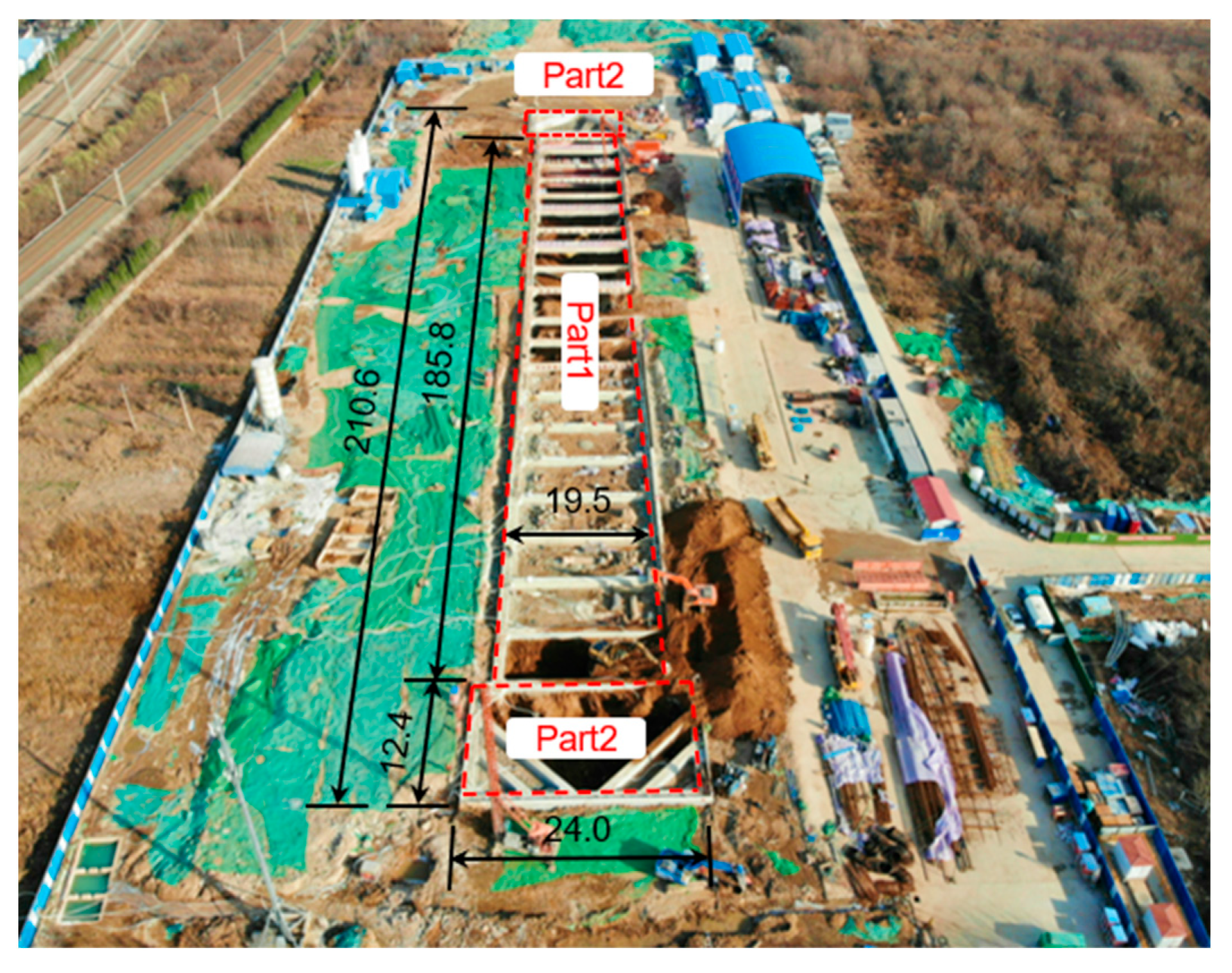
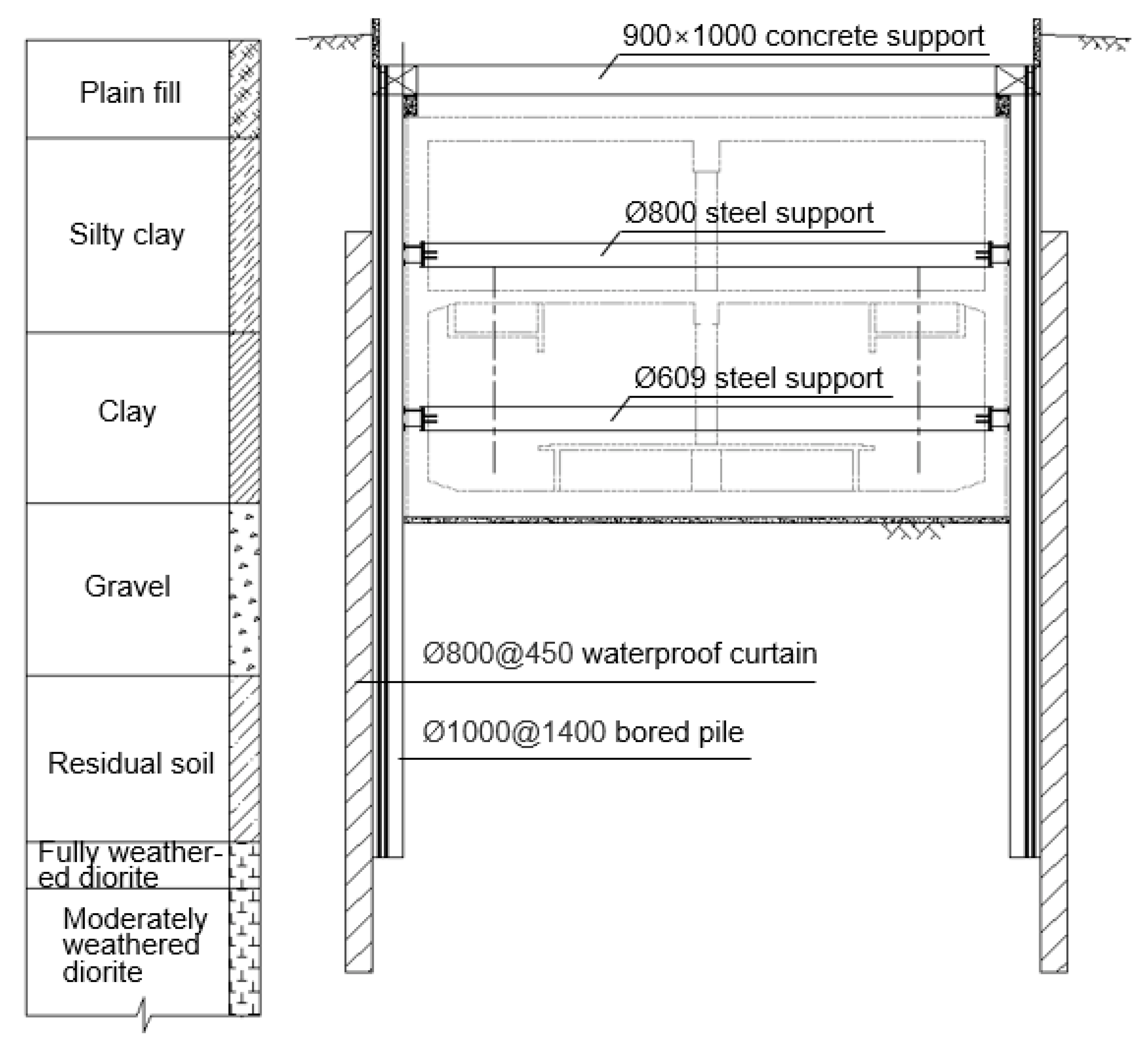

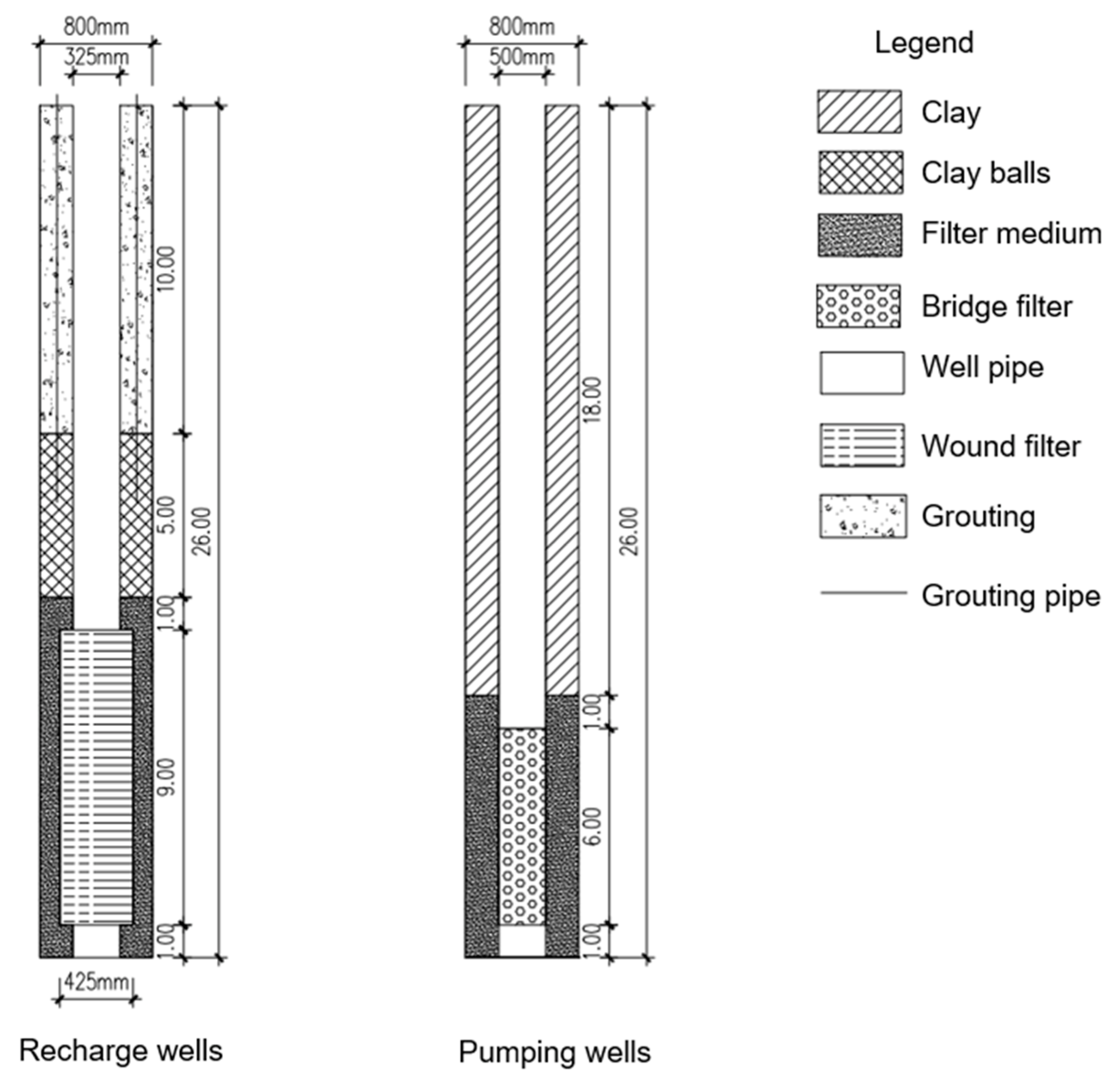
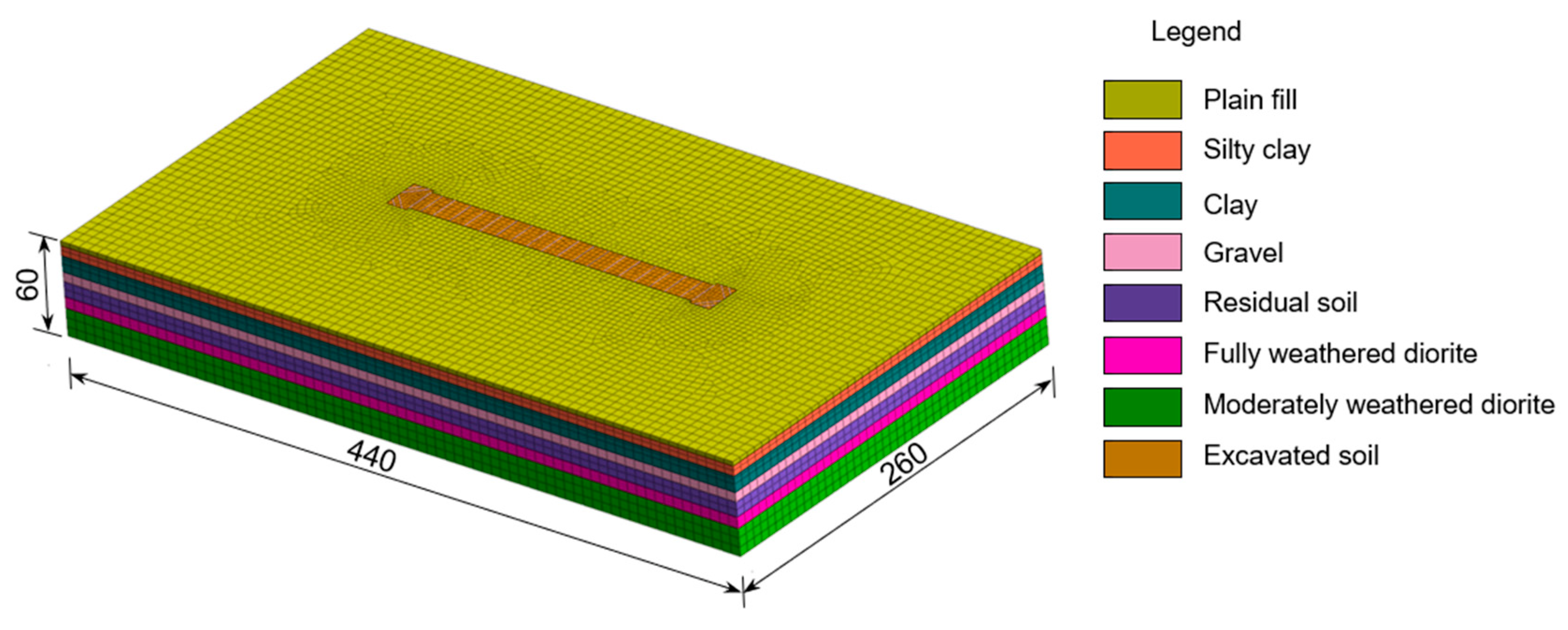
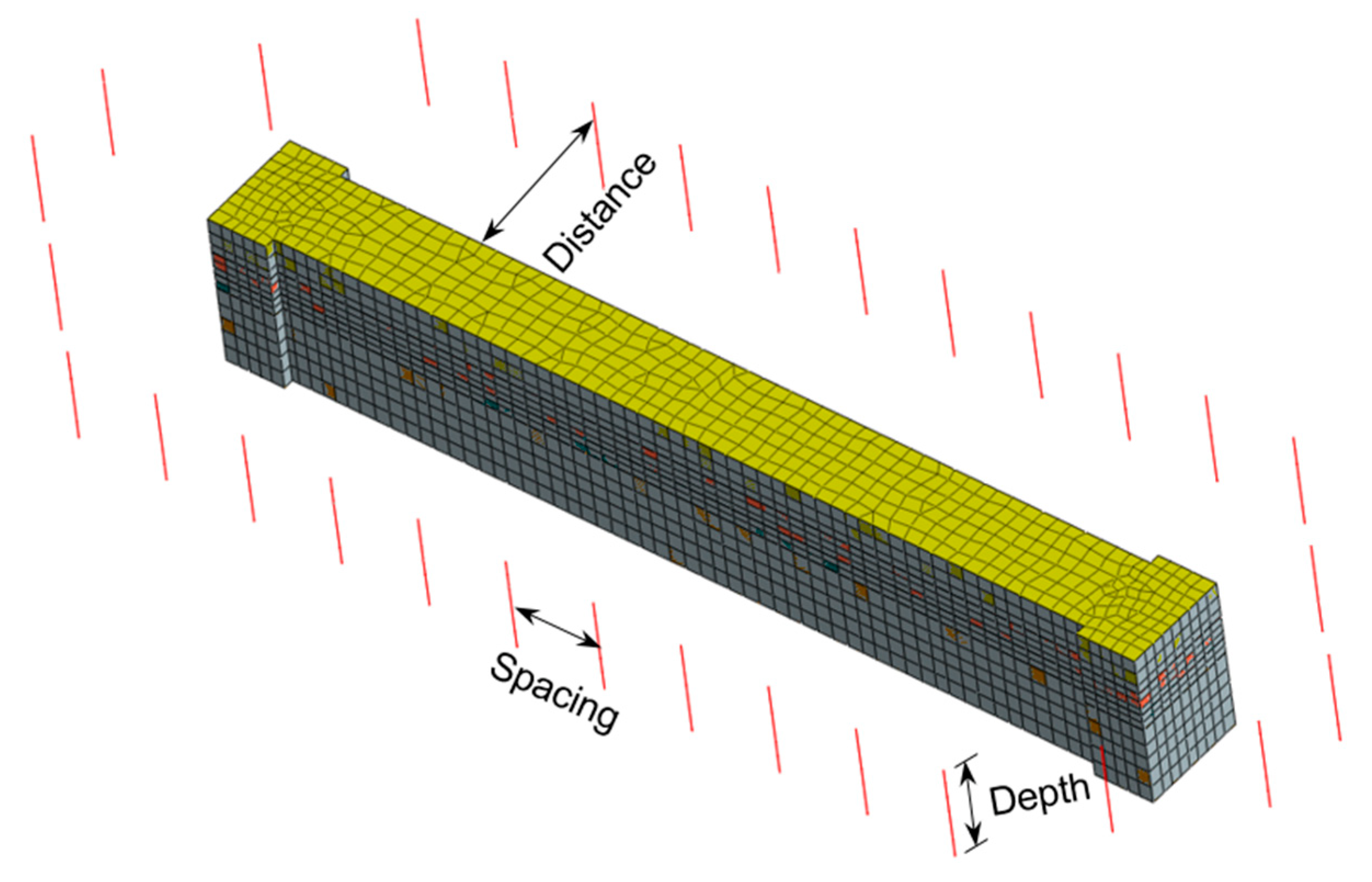

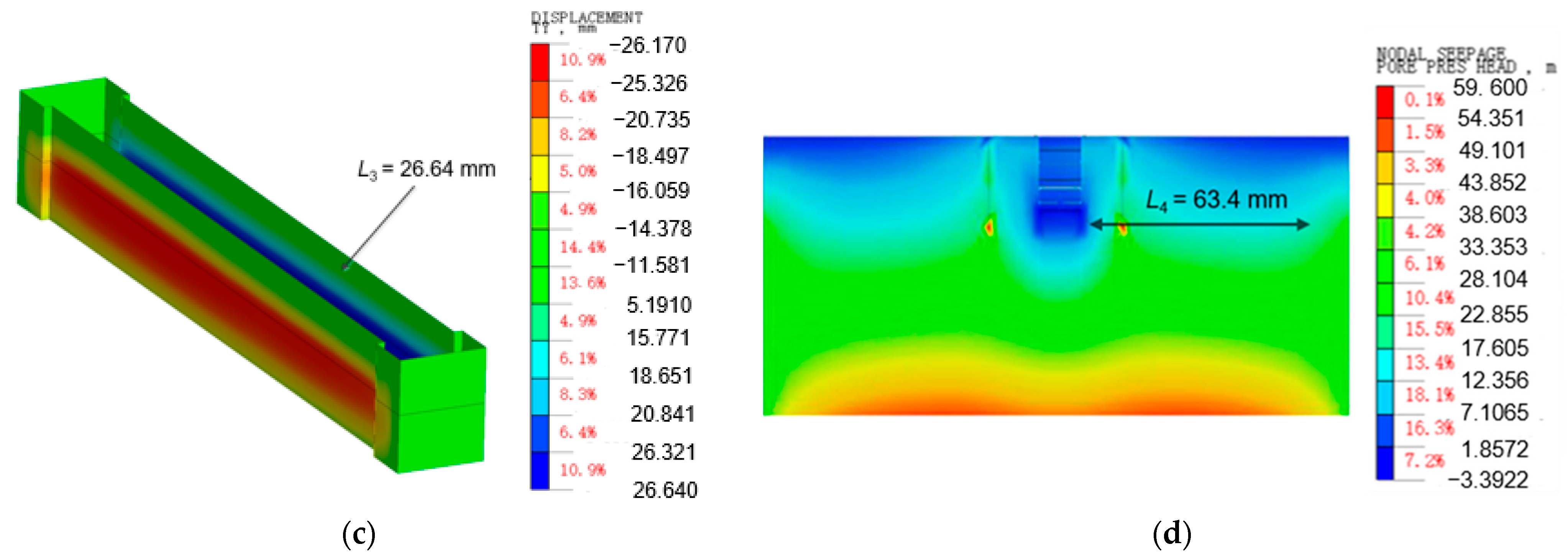





| Layer | Depth (m) | E (MPa) | v | φ (°) | C (kPa) | K (m/day) | γ (kN/m3) |
|---|---|---|---|---|---|---|---|
| Plain fill | 3 | 20.8 | 0.3 | 24.8 | 53.7 | 0.345 | 17.9 |
| Silty clay | 10 | 21.6 | 0.34 | 20.8 | 37.1 | 0.005 | 19.2 |
| Clay | 16 | 22.1 | 0.3 | 21.3 | 44.5 | 0.007 | 19.5 |
| Gravel | 22 | 26.5 | 0.26 | 16.3 | 28.1 | 3.5 | 19.3 |
| Residual soil | 27.5 | 28.7 | 0.33 | 18.3 | 50.8 | 1.38 | 17.4 |
| Fully weathered diorite | 29 | 32.3 | 0.28 | 33.4 | 32.2 | 1.296 | 20.6 |
| Moderately weathered diorite | 60 | 37.1 | 0.19 | 33.9 | 34.6 | 2.16 | 21.8 |
| Recharge Well Parameters | Level | ||||
|---|---|---|---|---|---|
| 1 | 2 | 3 | 4 | 5 | |
| Depth A (m) | 10 | 20 | 30 | 40 | 50 |
| Distance away from retaining structure B (m) | 12 | 20 | 40 | 60 | 80 |
| Spacing C (m) | 10 | 20 | 30 | 40 | 50 |
| Pressure D (kPa) | 10 | 20 | 30 | 40 | 50 |
| Scheme No. | Recharge Well Parameters | L1 (mm) | L2 (m3) | L3 (mm) | L4 (m) | L5 | |||
|---|---|---|---|---|---|---|---|---|---|
| A (m) | B (m) | C (m) | D (kPa) | ||||||
| Control group | Without recharge | −14.2 | 6.28 | 25.9 | 63.7 | 0 | |||
| 1 | 10 | 12 | 10 | 10 | −13.92 | 6.57 | 26.64 | 63.4 | 4 |
| 2 | 10 | 20 | 20 | 20 | −11.75 | 8.21 | 26.81 | 68.3 | 7 |
| 3 | 10 | 40 | 30 | 30 | −9.31 | 10.82 | 27.28 | 73.6 | 10 |
| 4 | 10 | 60 | 40 | 40 | −6.84 | 12.36 | 28.64 | 80.7 | 13 |
| 5 | 10 | 80 | 50 | 50 | −4.53 | 15.83 | 29.17 | 88.2 | 16 |
| 6 | 20 | 12 | 20 | 30 | −8.39 | 8.54 | 36.78 | 69.2 | 8 |
| 7 | 20 | 20 | 30 | 40 | −7.92 | 13.46 | 26.75 | 67.4 | 11 |
| 8 | 20 | 40 | 40 | 50 | −4.28 | 16.74 | 32.67 | 71.1 | 14 |
| 9 | 20 | 60 | 50 | 10 | −12.85 | 7.23 | 26.17 | 78.8 | 12 |
| 10 | 20 | 80 | 10 | 20 | −11.23 | 11.32 | 25.99 | 96.1 | 10 |
| 11 | 30 | 12 | 30 | 50 | −3.18 | 17.24 | 38.88 | 66.7 | 12 |
| 12 | 30 | 20 | 40 | 10 | −11.83 | 7.49 | 26.92 | 69.8 | 10 |
| 13 | 30 | 40 | 50 | 20 | −10.37 | 8.98 | 26.32 | 69.7 | 13 |
| 14 | 30 | 60 | 10 | 30 | −8.35 | 10.62 | 27.82 | 90.6 | 11 |
| 15 | 30 | 80 | 20 | 40 | −5.59 | 15.88 | 27.49 | 98.8 | 14 |
| 16 | 40 | 12 | 40 | 20 | −8.91 | 10.18 | 27.94 | 63.9 | 11 |
| 17 | 40 | 20 | 50 | 30 | −6.82 | 16.28 | 28.92 | 71.7 | 14 |
| 18 | 40 | 40 | 10 | 40 | −4.59 | 16.82 | 31.82 | 73.9 | 12 |
| 19 | 40 | 60 | 20 | 50 | −4.01 | 18.63 | 34.78 | 89.1 | 15 |
| 20 | 40 | 80 | 30 | 10 | −10.66 | 8.69 | 27.52 | 93.6 | 13 |
| 21 | 50 | 12 | 50 | 40 | −3.28 | 19.88 | 39.78 | 64.8 | 15 |
| 22 | 50 | 20 | 10 | 50 | −1.24 | 21.36 | 40.49 | 67.9 | 13 |
| 23 | 50 | 40 | 20 | 10 | −7.62 | 9.87 | 27.84 | 71.6 | 11 |
| 24 | 50 | 60 | 30 | 20 | −5.74 | 13.63 | 28.23 | 76.8 | 14 |
| 25 | 50 | 80 | 40 | 30 | −4.37 | 16.84 | 28.87 | 83.4 | 17 |
| Parameters | A | B | C | D | |
|---|---|---|---|---|---|
| No. | |||||
| K1 | −46.35 | −37.68 | −39.33 | −56.88 | |
| K2 | −44.67 | −39.56 | −37.36 | −48.00 | |
| K3 | −39.32 | −36.17 | −36.81 | −37.24 | |
| K4 | −34.99 | −37.79 | −36.23 | −28.22 | |
| K5 | −22.25 | −36.38 | −37.85 | −17.24 | |
| R2 | 24.10 | 3.39 | 3.10 | 39.64 | |
| Ranking of sensitivity | D > A > B > C | ||||
| Optimal scheme | A5 | B5 | C4 | D5 | |
| Parameters | A | B | C | D | |
|---|---|---|---|---|---|
| No. | |||||
| K1 | 53.79 | 62.41 | 66.69 | 39.85 | |
| K2 | 57.29 | 66.80 | 61.13 | 52.32 | |
| K3 | 60.21 | 63.23 | 63.84 | 63.10 | |
| K4 | 70.60 | 62.47 | 63.61 | 78.40 | |
| K5 | 81.58 | 68.56 | 68.20 | 89.80 | |
| R2 | 27.79 | 6.09 | 7.07 | 49.95 | |
| Ranking of sensitivity | D > A > C > B | ||||
| Optimal scheme | A5 | B5 | C5 | D5 | |
| Parameters | A | B | C | D | |
|---|---|---|---|---|---|
| No. | |||||
| K1 | 138.54 | 170.02 | 152.76 | 135.09 | |
| K2 | 148.36 | 149.89 | 153.7 | 135.29 | |
| K3 | 147.43 | 145.93 | 148.66 | 149.67 | |
| K4 | 150.98 | 145.64 | 145.04 | 154.48 | |
| K5 | 165.21 | 139.04 | 150.36 | 175.99 | |
| R3 | 26.67 | 30.98 | 8.66 | 40.90 | |
| Ranking of sensitivity | D > B > A > C | ||||
| Optimal scheme | A1 | B5 | C4 | D1 | |
| Parameters | A | B | C | D | |
|---|---|---|---|---|---|
| No. | |||||
| K1 | 374.2 | 328 | 391.9 | 372.7 | |
| K2 | 382.6 | 345.1 | 397 | 374.8 | |
| K3 | 395.6 | 359.9 | 373.6 | 388.5 | |
| K4 | 392.2 | 416 | 368.9 | 385.6 | |
| K5 | 364.5 | 460.1 | 373.2 | 383.0 | |
| R4 | 31.1 | 132.1 | 28.1 | 15.8 | |
| Ranking of sensitivity | B > A > C > D | ||||
| Optimal scheme | A5 | B1 | C4 | D1 | |
| Parameters | A | B | C | D | |
|---|---|---|---|---|---|
| No. | |||||
| K1 | 50 | 48 | 50 | 50 | |
| K2 | 55 | 52 | 55 | 55 | |
| K3 | 60 | 60 | 60 | 60 | |
| K4 | 65 | 65 | 65 | 65 | |
| K5 | 70 | 70 | 70 | 70 | |
| R5 | 20 | 22 | 20 | 20 | |
| Ranking of sensitivity | B > A = C = D | ||||
| Optimal scheme | A1 | B1 | C1 | D1 | |
| Scheme No. | Recharge Well Parameters | L1 (mm) | L2 (m3) | L3 (mm) | L4 (m) | L5 | |||
|---|---|---|---|---|---|---|---|---|---|
| A (m) | B (m) | C (m) | D (kPa) | ||||||
| Control group | Without recharge | −14.2 | 6.28 | 25.9 | 63.7 | 0 | |||
| Optimized scheme | 50 | 20 | 10 | 40 | −1.53 | 19.01 | 29.31 | 70.6 | 12 |
| Original scheme | 26 | 15 | 25 | 50 | −5.31 | 16.98 | 34.73 | 65.0 | 12 |
Disclaimer/Publisher’s Note: The statements, opinions and data contained in all publications are solely those of the individual author(s) and contributor(s) and not of MDPI and/or the editor(s). MDPI and/or the editor(s) disclaim responsibility for any injury to people or property resulting from any ideas, methods, instructions or products referred to in the content. |
© 2023 by the authors. Licensee MDPI, Basel, Switzerland. This article is an open access article distributed under the terms and conditions of the Creative Commons Attribution (CC BY) license (https://creativecommons.org/licenses/by/4.0/).
Share and Cite
Wu, B.; Zhang, K.; Meng, G.; Suo, X. Optimization of Recharge Schemes for Deep Excavation in the Confined Water-Rich Stratum. Sustainability 2023, 15, 5432. https://doi.org/10.3390/su15065432
Wu B, Zhang K, Meng G, Suo X. Optimization of Recharge Schemes for Deep Excavation in the Confined Water-Rich Stratum. Sustainability. 2023; 15(6):5432. https://doi.org/10.3390/su15065432
Chicago/Turabian StyleWu, Bo, Ke Zhang, Guowang Meng, and Xiao Suo. 2023. "Optimization of Recharge Schemes for Deep Excavation in the Confined Water-Rich Stratum" Sustainability 15, no. 6: 5432. https://doi.org/10.3390/su15065432
APA StyleWu, B., Zhang, K., Meng, G., & Suo, X. (2023). Optimization of Recharge Schemes for Deep Excavation in the Confined Water-Rich Stratum. Sustainability, 15(6), 5432. https://doi.org/10.3390/su15065432





